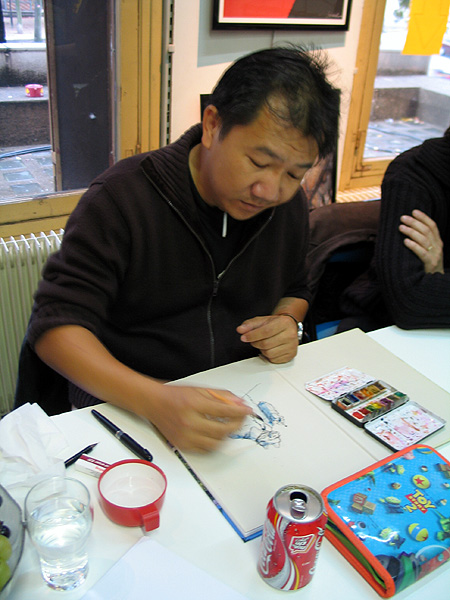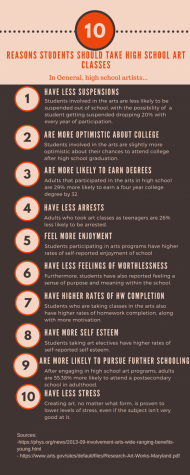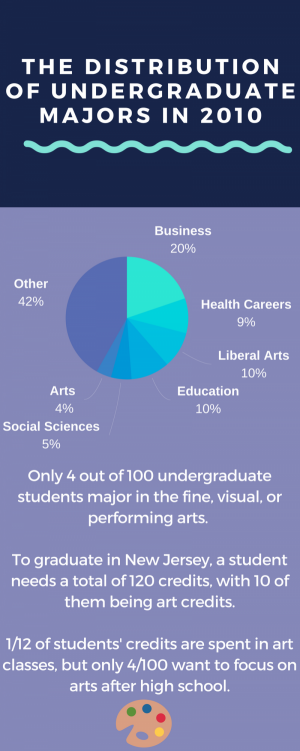The power of the art elective

Photo Credit: Wikipedia Commons
June 14, 2018
There are three identities that most directly impact my current (and future) academic careers. I am a Glen Rock High School student, I am mentally ill, and I am a self-described artist.
These three identities all bring me to be a firm supporter of a high school’s art electives. To many, they may just seem to be lighthearted, insipid activities at best, pointless time wasters at worst. However, there are many unseen benefits to art electives, making these classes crucial parts of one’s academic career.
As a Glen Rock High School student, the burden of the art elective requirements are not unfamiliar to me. However, I embrace these so-called “restrictions”. Art electives force me to go beyond my comfort zone and experience new forms of expressing myself. I would have not tried such escapades if I could completely dictate which high school classes to take.
There is an attitude apparent in many high schools that classes like math or science are the most “necessary” and far more important than an art class, or drama program. This is far from the truth for a student aspiring to work in the entertainment industry. Of course, it would be absolutely absurd to allow an aspiring artist or musician to skip out on crucial math classes, not necessarily because they must go through the invigorating task of memorizing the law of cosines, but because of the important skills in problem-solving and critical thinking mathematics excels at teaching. Similarly, taking an art class bolsters students’ motivation, self-esteem, and overall satisfaction in life. We, as a society, must realize that it is immoral to forego certain lessons for others due to their apparent “importance”, and just because one class may be deemed more useful than another, doesn’t mean that we can ignore the clear benefits of another.
As a person with mental illness (generalized anxiety, to be precise), art classes give me a place to allow myself to recover from the unrelenting stress I face on a day-to-day basis. I am not alone in my struggle. According to the National Institute of Mental Health, an estimated 31.9 percent of adolescents have an anxiety disorder. These rates are around ten percent higher than the anxiety disorder rates in adults, making this problem teen-specific. The fact that many teenagers are practically bombarded with stressors, especially in school, cannot be ignored. Stress can have numerous effects on one’s body and behavior: fatigue, lack of focus, and heightened substance abuse are only a few disastrous side effects. This is more than just a few teenagers feeling stressed out about classes- this is an epidemic.
Those “useless” art classes one may feel forced into taking can change that. Such art electives can give many students a reason to wake up in the morning- creating art is a known stress reliever, no matter what one’s talent level is. In a 2016 study measuring participants’ cortisol levels before and after making art, results proved that participating in sessions of making art significantly lower levels of cortisol, and that participants even reported that such art-making sessions were relaxing and enjoyable.
Finally, as an artist, I have come to realize that classes that build my creativity are just as, if not even more, important than a class that is far more logic-focused. However, I am able to understand that to become a well-rounded member of society, it is necessary to take classes that may not seem to tie into my future college major or career. It should be any school’s responsibility to equip its students with tools they can use to live happier and more successful lives in the future. There would be absolutely no debate over whether to allow students to skip a school’s class in basic algebra- everyone is aware of the necessary benefits derived from it. The same is true for art electives: no matter how inapplicable Photo I may seem to you, there is a reason these classes are required. The arts can teach lessons as well: life changing ones, one that teach and help and save children.
The kids can be alright. And the arts, of course, can guide them along the way.
 Photo Credit: Caroline Geoghegan
Photo Credit: Caroline Geoghegan



